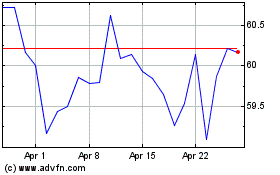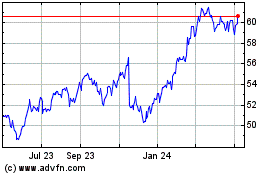By Annie Gasparro and Heather Haddon
Whole Foods Market Inc. lost its edge, and now it's losing its
independence.
With a sale to Amazon.com Inc. announced Friday, Whole Foods is
entering a new frontier, joining the mass retailers from which it
has long striven to differentiate itself.
For decades, the natural and organic food retailer grew faster
than the rest of the grocery industry by tapping into an emerging
population of affluent urbanites interested in a new way of eating
and grocery shopping. It had a certain cachet, with a distinct
offering of organic foods and specially trained salespeople
promoting an experience for which customers were willing to pay
more.
But in recent years, as mainstream grocers from Kroger Co. to
Wal-Mart Stores Inc. began stocking more natural and organic food
at cheaper prices, Whole Foods began to lose its advantage.
"They didn't do enough to continue to command the higher
prices," said Gaurav Gupta, a corporate-strategy consultant at
Kotter International. "Their competitive advantage has eroded
slowly over the last five years."
For nearly two years, Whole Foods, which has about 460 stores,
has faced its longest stretch of quarterly same-store sales
declines since it began trading on the stock market in 1992. Its
share price had been cut in half leading up to Friday's
announcement.
Amazon said it has agreed to acquire Whole Foods for $42 a share
in a deal valued at $13.7 billion, including debt.
Pressure on Whole Foods, and its co-founder and Chief Executive
John Mackey, mounted this year, when activist investor Jana
Partners, with several allies, unveiled a stake in Whole Foods and
publicly pushed the company to explore a sale. The new dynamic
added to shareholder tension that had been more quietly bubbling,
turning attention to the sliding results after years of being a
highflying stock.
Since it opened its first store in 1980, Whole Foods has prided
itself on its independence. Mr. Mackey, a strict vegan, aimed to
bring organic and natural food to the world. During the 1990s and
2000s, Whole Foods expanded rapidly, buying 11 regional health-food
chains and opening more stores. As recently as last year, he spoke
of expanding the chain to 1,200 stores in the U.S.
Whole Foods' problem with how customers perceived its prices
worsened in the summer of 2015, when the New York Department of
Consumer Affairs accused it of overcharging customers in nine
stores by putting incorrect weights on some items.
"That was when these other competitors were really starting to
ramp up, so that was when they needed to reverse that perception,
not reinforce the negative perception," said Sonia Lapinsky,
managing director in the retail practice at AlixPartners. Whole
Foods' sales and stock never came back from that, she said.
Whole Foods put its efforts toward lowering its prices compared
with rivals like Kroger. It expanded its private-label brand,
called 365, to more foods and opened a new line of smaller stores
called 365 by Whole Foods, aimed at offering overall lower
prices.
But it was too little too late, Wall Street analysts say.
Despite its efforts, Whole Foods' prices are still 20% to 30%
higher than mainstream grocers', according to consulting firm
OC&C Strategy Group. Earlier this year, Whole Foods said it was
closing several underperforming stores and no longer aiming for
1,200 locations in the U.S.
In November, Whole Foods said its longtime co-chief Walter Robb
would step down, leaving Mr. Mackey to make swifter decisions to
turn around the lagging business. Last year, Whole Foods' profit
declined by more than 5% and its comparable-store sales fell
2.5%.
Mr. Mackey moved more purchasing decisions to its Austin
headquarters and made other organizational changes to operate more
like a national grocer than a startup.
But Jana Partners said it wasn't enough. The activists pushed
for board changes and a slew of operational changes if the company
was going to prove it could stand alone. Neuberger Berman, a mutual
fund that doesn't typically speak publicly, and other investors
were calling for change as well.
In May, Whole Foods moved to shake up its board, naming five new
directors and planning to remove two others by the next annual
meeting. Jana, though, balked at a settlement offer that would have
given the hedge fund only a few seats. That kept the public
pressure on the company.
Whole Foods and Jana declined to comment on Friday. Neuberger
Berman portfolio manager Charles Kantor applauded the strategic
move of uniting with Amazon, but also speculated the bid could be
topped.
The unique problems facing Whole Foods came as the grocery
sector more broadly continued to grapple with a host of pressures.
In recent years, consumers have been buying more of groceries
through online merchants, with discounters and meal-kit delivery
services all grabbing market share. A glut in commodities from
grains to meat has brought down prices for many staple foods over
the past 18 months, putting pressure on many retailers to lower
their prices.
Amazon brings an innovative, technology-driven perspective to
Whole Foods that could help it improve, analysts say. Mr. Mackey
will remain chief executive of Whole Foods and the stores will
continue to operate under the Whole Foods brand and maintain its
suppliers.
Richard Gerber, a former Whole Foods regional president whose
Florida-based health-food chain was acquired by the grocer in 1997,
welcomed the Amazon bid. He said Mr. Mackey was an innovator in
their sector for a period, but that things in the industry have
since changed.
"We are granola people but it's about profitability. It's for
your shareholders," said Mr. Gerber, who consults in grocery and is
a Whole Foods shareholder. "Whole Foods has been unable to find
their way. They've been lost in the forest for a long time and they
haven't been able to reinvent themselves fast enough."
-- David Benoit contributed to this article.
Write to Annie Gasparro at annie.gasparro@wsj.com and Heather
Haddon at heather.haddon@wsj.com
(END) Dow Jones Newswires
June 16, 2017 15:47 ET (19:47 GMT)
Copyright (c) 2017 Dow Jones & Company, Inc.
Walmart (NYSE:WMT)
Historical Stock Chart
From Mar 2024 to Apr 2024

Walmart (NYSE:WMT)
Historical Stock Chart
From Apr 2023 to Apr 2024
